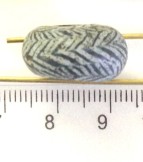 Line style is a fairly straightforward category. This basically describes the pattern of any lines that decorate the bead – not the pattern those lines make, but the pattern they have.
Line style is a fairly straightforward category. This basically describes the pattern of any lines that decorate the bead – not the pattern those lines make, but the pattern they have.
There are only a few options for this. First is a monochrome line. The line is a single colour, nothing more. This is the most common style; most line styles are monochrome.
 But there are also beads with polychrome lines, for which there are three main categories. The first is symmetrically polychrome lines. These could be two lines, one white and one yellow, which follow the same path and therefore act as a single line. Or it could be a thick base with a thinner line of a different colour covering it. These lines are technically separate, but effectively the same line.
But there are also beads with polychrome lines, for which there are three main categories. The first is symmetrically polychrome lines. These could be two lines, one white and one yellow, which follow the same path and therefore act as a single line. Or it could be a thick base with a thinner line of a different colour covering it. These lines are technically separate, but effectively the same line.
You can also have asymmetrical polychrome lines. This might be two separate colours, but with no real pattern to them.
 Finally, you can have reticella lines, like the central line in this photo. Reticella refers to a polychrome rod of glass that is made by twisting at least two differently coloured rods together to create a tightly wound spiral of multi-coloured glass. One of these colours is often transparent or translucent and lighter than the other colour, so that the twisted pattern can be seen through the bead.
Finally, you can have reticella lines, like the central line in this photo. Reticella refers to a polychrome rod of glass that is made by twisting at least two differently coloured rods together to create a tightly wound spiral of multi-coloured glass. One of these colours is often transparent or translucent and lighter than the other colour, so that the twisted pattern can be seen through the bead.
 There are plenty of beads that are made entirely out of reticella lines, such that the glass used to wind the bead is reticella. The resulting patterns looks a lot like the twisted quality of rope. In this case, there aren’t really lines in the bead – it simply is reticella. I am still debating the best way to note this, but I don’t feel it should be in the line styles section. Normally I put this under how the bead is manufactured, rather than under design.
There are plenty of beads that are made entirely out of reticella lines, such that the glass used to wind the bead is reticella. The resulting patterns looks a lot like the twisted quality of rope. In this case, there aren’t really lines in the bead – it simply is reticella. I am still debating the best way to note this, but I don’t feel it should be in the line styles section. Normally I put this under how the bead is manufactured, rather than under design.
 Remember that you can also have no lines on a bead – like eye beads. In these cases, you shouldn’t leave that section blank – actually write ‘none’ where line style would normally go. This tells other readers (and your future self!) that you did pay attention to whether there were lines found there were none, rather than that you didn’t look at or document the lines on the bead.
Remember that you can also have no lines on a bead – like eye beads. In these cases, you shouldn’t leave that section blank – actually write ‘none’ where line style would normally go. This tells other readers (and your future self!) that you did pay attention to whether there were lines found there were none, rather than that you didn’t look at or document the lines on the bead.

